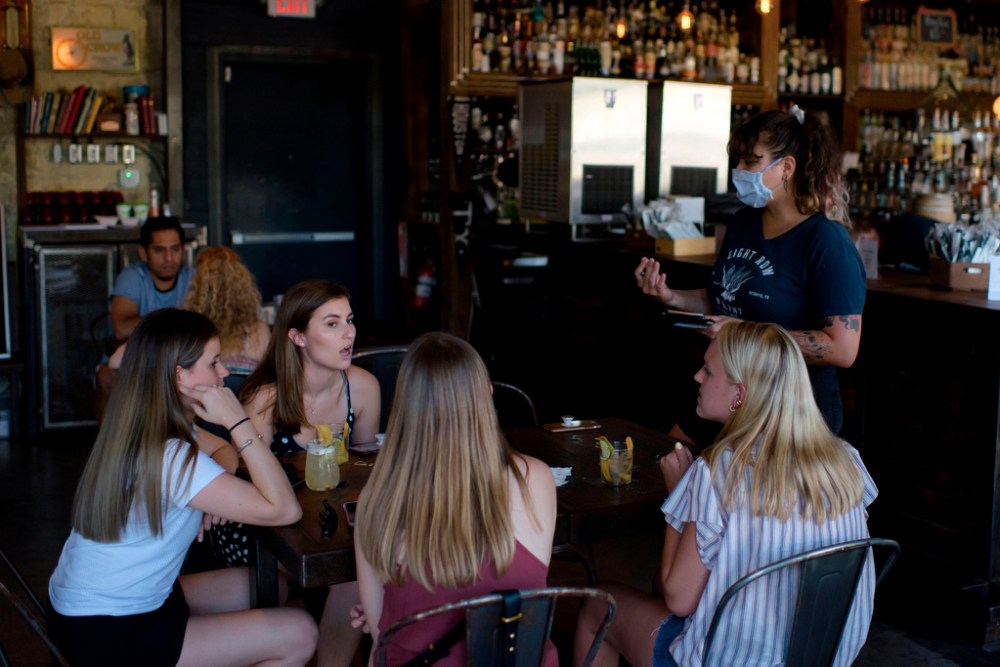U.S. case totals show dangers of rapid reopening
Read this article for free:
or
Already have an account? Log in here »
To continue reading, please subscribe:
Monthly Digital Subscription
$0 for the first 4 weeks*
- Enjoy unlimited reading on winnipegfreepress.com
- Read the E-Edition, our digital replica newspaper
- Access News Break, our award-winning app
- Play interactive puzzles
*No charge for 4 weeks then price increases to the regular rate of $19.00 plus GST every four weeks. Offer available to new and qualified returning subscribers only. Cancel any time.
Monthly Digital Subscription
$4.75/week*
- Enjoy unlimited reading on winnipegfreepress.com
- Read the E-Edition, our digital replica newspaper
- Access News Break, our award-winning app
- Play interactive puzzles
*Billed as $19 plus GST every four weeks. Cancel any time.
To continue reading, please subscribe:
Add Free Press access to your Brandon Sun subscription for only an additional
$1 for the first 4 weeks*
*Your next subscription payment will increase by $1.00 and you will be charged $16.99 plus GST for four weeks. After four weeks, your payment will increase to $23.99 plus GST every four weeks.
Read unlimited articles for free today:
or
Already have an account? Log in here »
Hey there, time traveller!
This article was published 15/06/2020 (2003 days ago), so information in it may no longer be current.
Recent waves of holiday-weekend beach parties and continuing street protests in the United States were followed on the weekend by a spike in new cases of COVID-19. It was not exactly the long-foretold second wave of the coronavirus pandemic; nonetheless, world stock markets cringed at the reminder of what the second wave might look like.
In the view of Dr. Anthony Fauci, the U.S. government’s chief arbiter of pandemic interpretation, we will see the second wave when hospital admissions for COVID-19 increase. It may happen or it may not.
What did happen in recent days was a sharp increase in gross totals of newly-reported COVID-19 cases in Florida, Texas, Arizona and North Carolina. Those states have been among the most aggressive in re-opening businesses and relaxing restrictions on social gatherings. Other states reported smaller increases in new cases.

Those figures lumped together data of varying quality from many sources. They showed nothing about when and how the patients were infected, how serious their symptoms were and how certain the diagnosis was. When hospitals report admitting people for treatment of COVID-19, you know the symptoms are bad and the diagnosis is probably accurate. Those are the numbers Dr. Fauci is waiting for.
Stock markets, however, did not stop Monday morning to puzzle over the fine points of epidemiological science. They put two and two together and the answer was: sell. Share prices for airlines and cruise companies were hit hardest.
Canadian provinces, too, have been re-opening businesses and relaxing restrictions, but cautiously for the most part. Daily totals of new Canadian cases continued their gradual decline. Canada’s national total of new cases, which was running around 1,000 a day all through May, stayed below 500 a day for the last week.
The increase in U.S. cases provides a warning that some U.S. states are not achieving an efficient exit from their April-May lockdowns. If Texas, Florida and perhaps other populous states after them start seeing their hospitals fill with COVID-19 patients once again, then the economic problem will also return. Public fear of crowded places will return. Restaurants and retailers will have to close their doors or impose restrictions. Unemployment will climb once again.
Canada has to keep a close eye on how well the U.S. is managing its pandemic recovery. Most travellers entering Canada, some of whom are virus carriers, arrive from the United States. Most of the imported goods Canadians consume come from the U.S. Most of the partly-manufactured goods that our industries use were prepared in the U.S.

A fresh decline in U.S. industrial performance is going to hurt Canadian business, even if this country does a good job of curbing coronavirus spread. Any fresh upsurge in virus contagion in the U.S. is going to force the two countries to keep the border closed on both sides.
Some business leaders and lobby groups in the U.S. have been urging a quick return to normal on the grounds that COVID-19, though inconvenient, is not a problem of a magnitude that justifies curtailment of commerce and production. President Donald Trump was reasoning as recently as May 22 that the cure should not be worse than the problem.
If pandemic control were as easy as mouthing slogans, that could be a useful insight. In practice, however, you cannot tell how fast to relax the lockdown until a few weeks after you have relaxed too fast — and then you’re back where you started.




